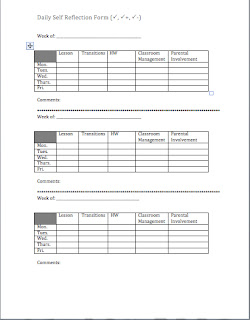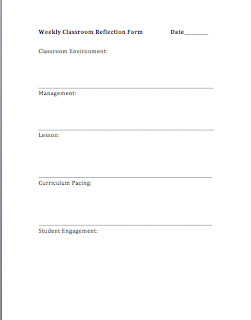 |
| Self-reflection is a great way to identify your instructional strengths |
It's always a good idea to know how you're doing as a teacher. But who is better than you to be able to identify your growth? That's the beauty of self-reflection. However, many of us don't take to time to formally gauge our effectiveness. Here's a calendar for self-review that you may find helpful. Use a schedule that's offered below, or any type that you desire. The point is, you need to develop a systematic review of your practice:
Daily: create a basic table with 5 items and a space for each day (5 columns, 5 rows). Below you see a sample of a form that you can develop for yourself. If you put three copies on a form, you have a record that lasts for three weeks. Run off enough copies to last the year. Simply give yourself a check plus (equal to an "A" grade), check (equal to a "C" grade) or check minus (equal to an "F" grade) for your lessons, homework, transitions, classroom management, and parental contacts. You may want to add a column for comments as well! If you compare your reflections to your plans you will have a one-stop evaluation tool of what worked in class and what didn't work. This will provide a system to help you in future lesson planning and presentation.
Weekly: use a copy of your school's informal quick visit form or draft one yourself. Nothing formal, simply create narrative sections for classroom environment, management, lesson, curriculum pacing and student engagement. Complete a short reflection (one or two sentences) in each section. It will give you a bird's eye view of your classroom. If your school has informal visit forms, compare the one you receive from your administrator with your own. That will help you identify your perceived and actual strengths and weaknesses.
Monthly: use your school's formal observation form
Complete the formal form used to evaluate your performance. It's better to evaluate your own practice before the administrator arrives. By doing this, you can begin to address problem areas and begin to upgrade your practice. If your problem areas persist, address them yourself by attending professional development sessions.
Annually: a more extensive evaluation form that measures details of your practice
It can be a two part review that includes your students' perspectives as well as your own perspective, or either one of your choosing.
Student evaluation
Many teachers have their students complete an evaluation form at the end of the year (or semester)
Sample:
http://www.rucharacter.org/file/Microsoft%20Word%20-%20Teacher%20Evaluation%20by%20Students(1).pdf
Self reflection
Here is a very thorough self reflective survey (22 pages) that will measure just about every aspect of your teaching practice. It's a pdf file, so take a moment to print it off, and then complete it.
Sample:
http://www.incredibleyears.com/Resources/TCM_Self_Reflection_Inventory.pdf
Try to develop a binder during the summer that will hold copies of your reflections - you may even want to have them dated and ready to use once school begins again! The trick is to begin the reflective process, and be consistent. Also, once you begin a reflective practice, remember to address those areas where you need help and celebrate your successes!
Thoughtfully yours,




Thanks for the information.
ReplyDeleteHaving just started paying attention to this practice, hope to employ your suggestions and let you know how they worked.
I hope that you have success with this process - thanks for leaving a comment.
ReplyDelete